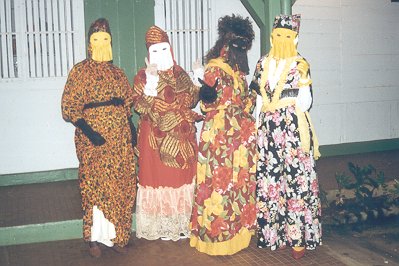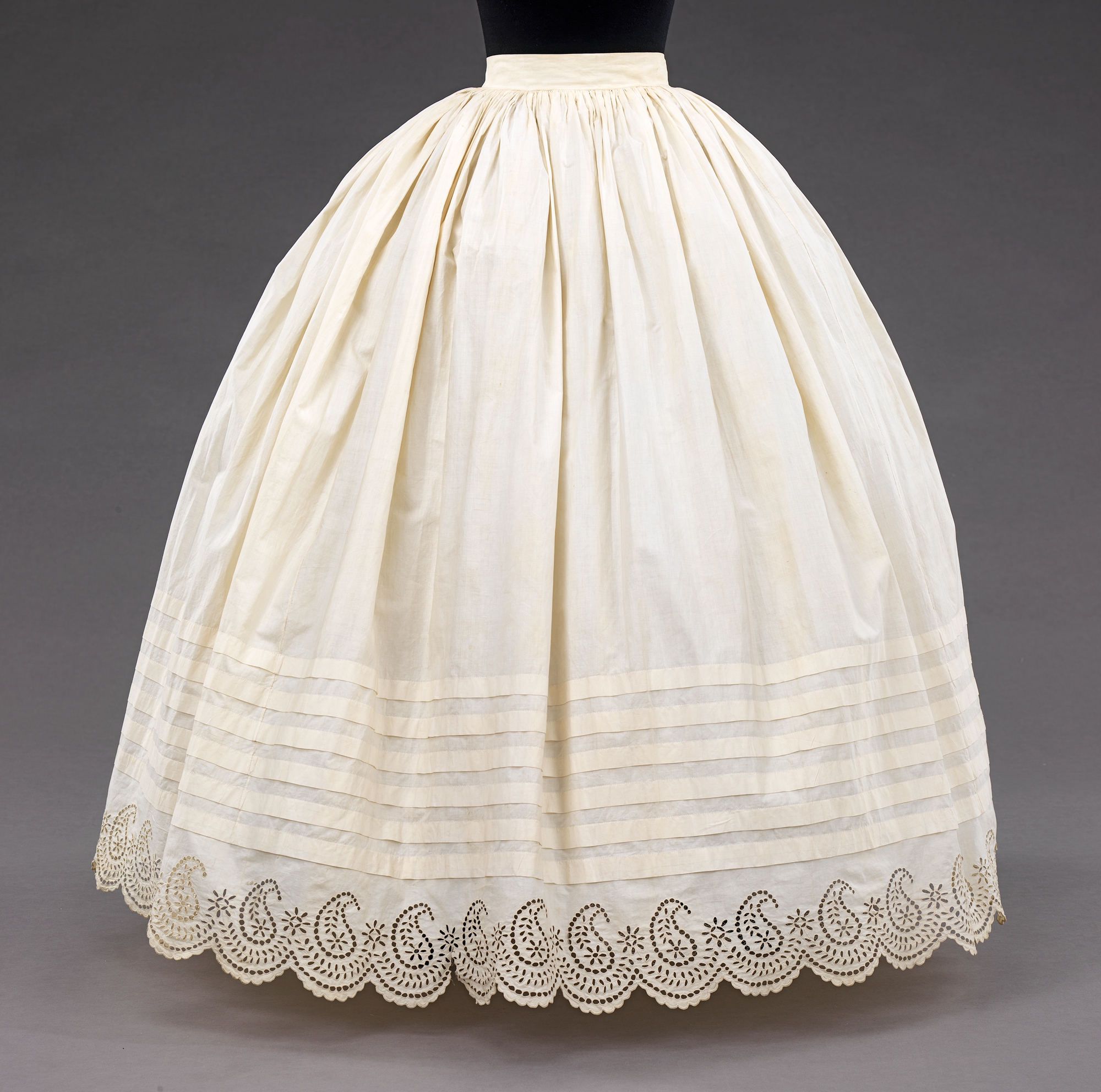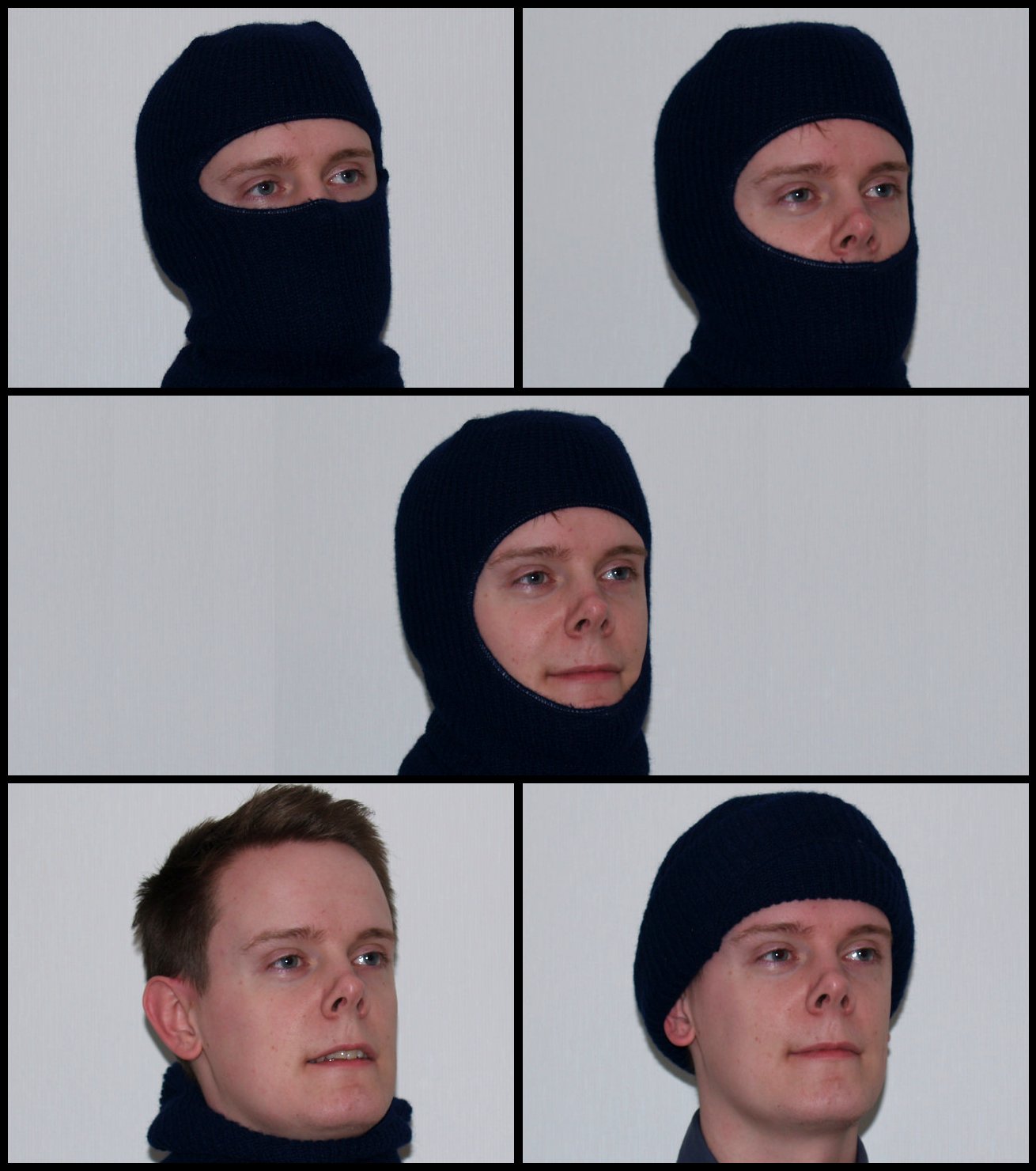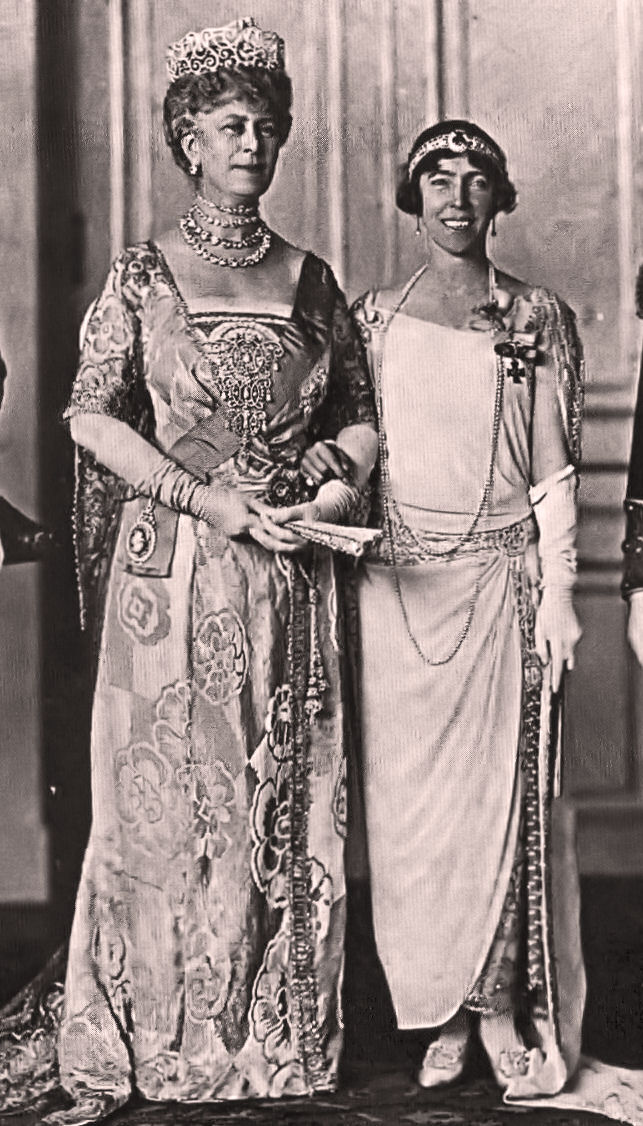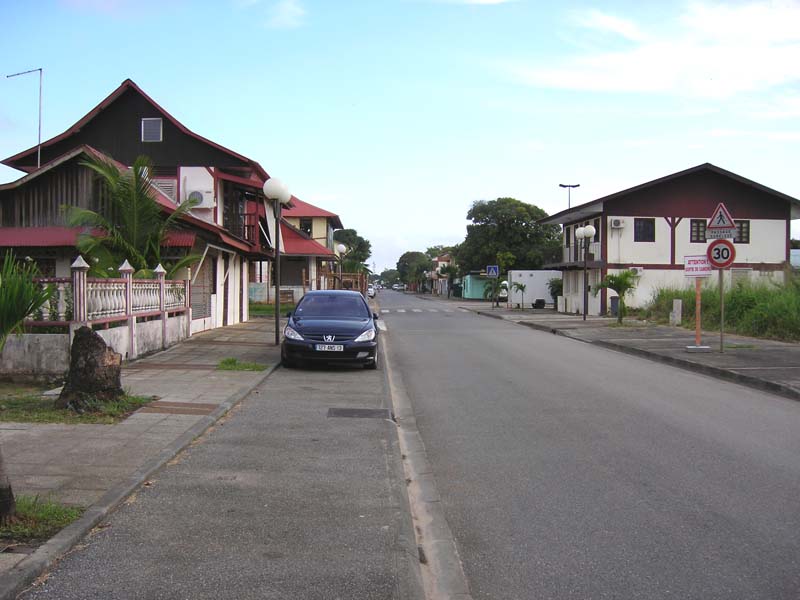|
Touloulou Devant Son Université
The Touloulou is the most famous of the typical characters and the queen of Guianan carnival. Description The Touloulou is the queen of the carnival. It is a lady elegantly dressed from head to toe. They are normally women without an inch of skin showing. She wears a petticoat, a balaclava, a Domino mask and long gloves. In order not to be recognized, women go so far as to put colored lenses, wigs and camouflage their voices. They do not wear their usual perfume, buy pairs of shoes for the occasion that they will not return and do not move with their vehicle to remain anonymous. They parade in the street and participate in masked balls. There is also a men's suit called Tololo. In the nightclubs, renamed occasionally "universities", it is the touloulous who invite men to dance. They cannot refuse. Origin This typical figure of Guianan Creole culture represents the bourgeois women of the 18 and 19th centuries, in their Sunday best, dressed in their heads to the feet. Thi ... [...More Info...] [...Related Items...] OR: [Wikipedia] [Google] [Baidu] |
Carnival In French Guiana
Carnival in French Guiana is a major event. Its style is described as Afro-Caribbean. A moveable holiday, it takes place between Epiphany and Ash Wednesday, ending on Mardi Gras. Known internationally for its Paré-masqué balls and its emblematic character, the Touloulou, it is considered the longest carnival in the world. The participants – French, Creole, Brazilian and Chinese people – dress in vibrant costumes. Main events include a parade and a burlesque-style marriage. Background This celebration is a cultural tradition of the Guianan Creole, its origin traced to carnival customs practiced in Europe. It debuted during the beginning of colonization, between the 1600 and 1700 centuries. When settlers took part in carnival, forbidding the slaves from participating. Defying the ban, the slaves practiced carnival in clandestine ways, seeing it as a way to regain some freedom, to commemorate African fertility, and to deride the settlers. In the present day, metropoli ... [...More Info...] [...Related Items...] OR: [Wikipedia] [Google] [Baidu] |
Petticoat
A petticoat or underskirt is an article of clothing, a type of undergarment worn under a skirt or a dress. Its precise meaning varies over centuries and between countries. According to the ''Oxford English Dictionary'', in current British English, a petticoat is "a light loose undergarment ... hanging from the shoulders or waist". In modern American usage, "petticoat" refers only to a garment hanging from the waist. They are most often made of cotton, silk or tulle. Without petticoats, skirts of the 1850s would not have the volume they were known for. In historical contexts (16th to mid-19th centuries), ''petticoat'' refers to any separate skirt worn with a gown, bedgown, bodice or jacket; these petticoats are not, strictly speaking, underwear, as they were made to be seen. In both historical and modern contexts, ''petticoat'' refers to skirt-like undergarments worn for warmth or to give the skirt or dress the desired attractive shape. Terminology Sometimes a petticoat may be ... [...More Info...] [...Related Items...] OR: [Wikipedia] [Google] [Baidu] |
Balaclava (clothing)
A balaclava, also known as a balaclava helmet or ski mask, is a form of cloth headgear designed to expose only part of the face, usually the eyes and mouth. Depending on style and how it is worn, only the eyes, mouth and nose, or just the front of the face are unprotected. Versions with enough of a full face opening may be rolled into a hat to cover the crown of the head or folded down as a collar around the neck. History Similar styles of headgear were known in the 19th century as the ''Uhlan cap'' worn by Polish and Prussian soldiers, and the ''Templar cap'' worn by outdoor sports enthusiasts. The name comes from their use at the Battle of Balaclava during the Crimean War of 1854, referring to the town near Sevastopol in the Crimea, where British troops there wore knitted headgear to keep warm. Handmade balaclavas were sent over to the British troops to help protect them from the bitter cold weather. British troops required this aid, as their own supplies (warm clothing, w ... [...More Info...] [...Related Items...] OR: [Wikipedia] [Google] [Baidu] |
Domino Mask
Dominoes is a family of tile-based games played with gaming pieces, commonly known as dominoes. Each domino is a rectangular tile, usually with a line dividing its face into two square ''ends''. Each end is marked with a number of spots (also called '' pips'' or ''dots'') or is blank. The backs of the tiles in a set are indistinguishable, either blank or having some common design. The gaming pieces make up a domino set, sometimes called a ''deck'' or ''pack''. The traditional European domino set consists of 28 tiles, also known as pieces, bones, rocks, stones, men, cards or just dominoes, featuring all combinations of spot counts between zero and six. A domino set is a generic gaming device, similar to playing cards or dice, in that a variety of games can be played with a set. Another form of entertainment using domino pieces is the practice of domino toppling. The earliest mention of dominoes is from Song dynasty China found in the text ''Former Events in Wulin'' by Zhou Mi (1 ... [...More Info...] [...Related Items...] OR: [Wikipedia] [Google] [Baidu] |
Long Gloves
Ladies' evening gloves or opera gloves are a type of formal glove that reaches beyond the elbow. Ladies' gloves for formal and semi-formal wear come in three lengths for women: wrist, elbow, and opera or full-length (over the elbow, usually reaching to the biceps but sometimes to the full length of the arm). The most expensive full-length gloves are custom-made of kidskin. Many other types of leather, most usually soft varieties of cowhide, are used in making full-length gloves; patent leather and suede are especially popular as alternatives to kidskin, and are often more affordable than kidskin. Satin and stretch satin materials are extremely popular, and there are mass-produced varieties as well. More unusual glove materials include leathers made from salmon, python, and stingray. History Western world While the etymology of the term ''opera glove'' is unknown, gloves of above-the-elbow length have been worn since at least the late 18th century, and gloves reaching to or j ... [...More Info...] [...Related Items...] OR: [Wikipedia] [Google] [Baidu] |
Touloulou Devant Son Université
The Touloulou is the most famous of the typical characters and the queen of Guianan carnival. Description The Touloulou is the queen of the carnival. It is a lady elegantly dressed from head to toe. They are normally women without an inch of skin showing. She wears a petticoat, a balaclava, a Domino mask and long gloves. In order not to be recognized, women go so far as to put colored lenses, wigs and camouflage their voices. They do not wear their usual perfume, buy pairs of shoes for the occasion that they will not return and do not move with their vehicle to remain anonymous. They parade in the street and participate in masked balls. There is also a men's suit called Tololo. In the nightclubs, renamed occasionally "universities", it is the touloulous who invite men to dance. They cannot refuse. Origin This typical figure of Guianan Creole culture represents the bourgeois women of the 18 and 19th centuries, in their Sunday best, dressed in their heads to the feet. Thi ... [...More Info...] [...Related Items...] OR: [Wikipedia] [Google] [Baidu] |
Guianan Creole
French Guianese Creole (Kriyòl; also called variously Guianan Creole, Guianese Creole in English and Créole guyanais or Guyanais in French) is a French-based creole language spoken in French Guiana, and to a lesser degree, in Suriname and Guyana. It resembles Antillean Creole, but there are some lexical and grammatical differences between them. Antilleans can generally understand French Guianese Creole, though there may be some instances of confusion. The differences consist of more French and Brazilian Portuguese influences (due to the proximity of Brazil and Portuguese presence in the country for several years). There are also words of Amerindian and African origin. There are French Guianese communities in Suriname and Guyana who continue to speak the language. It should not be confused with the Guyanese Creole language, based on English, spoken in nearby Guyana. History French Guianese Creole was a language spoken between slaves and settlers. But the conditions ... [...More Info...] [...Related Items...] OR: [Wikipedia] [Google] [Baidu] |
French Guiana
French Guiana ( or ; french: link=no, Guyane ; gcr, label=French Guianese Creole, Lagwiyann ) is an overseas departments and regions of France, overseas department/region and single territorial collectivity of France on the northern Atlantic Ocean, Atlantic coast of South America in the Guianas. It borders Brazil to the east and south and Suriname to the west. With a land area of , French Guiana is the second-largest Regions of France, region of France (more than one-seventh the size of Metropolitan France) and the largest Special member state territories and the European Union, outermost region within the European Union. It has a very low population density, with only . (Its population is less than that of Metropolitan France.) Half of its 294,436 inhabitants in 2022 lived in the metropolitan area of Cayenne, its Prefectures in France, capital. 98.9% of the land territory of French Guiana is covered by forests, a large part of which is Old-growth forest, primeval Tropical r ... [...More Info...] [...Related Items...] OR: [Wikipedia] [Google] [Baidu] |
Kourou
Kourou () is a commune in French Guiana, an overseas region and department of France in South America. Kourou is famous for being the location of the Guiana Space Centre, the main spaceport of France and the European Space Agency (ESA). It is an administrative district in French Guiana and the main town there. Geography Some northwest of the French Guianese capital Cayenne the Kourou River empties into the Atlantic Ocean. At the mouth of this river sits the town of Kourou, which is ringed by four hills: Carapa, Pariacabo, Café and Lombard, with the Singes and Condamine mountains not far behind. There are three lakes within the town's city limits: Lake Bois Diable (where one can take lessons in jetski and other aquatic sports), Lake Marie-Claire (the smallest and calmest), and Lake Bois Chaudat (the biggest of the three; also open to sport lovers, especially canoers and kayakers). Long white sand beaches and some rocky outcrops line the town's ocean coast, the riverbank ... [...More Info...] [...Related Items...] OR: [Wikipedia] [Google] [Baidu] |
Carnival
Carnival is a Catholic Christian festive season that occurs before the liturgical season of Lent. The main events typically occur during February or early March, during the period historically known as Shrovetide (or Pre-Lent). Carnival typically involves public celebrations, including events such as parades, public street parties and other entertainments, combining some elements of a circus. Elaborate costumes and masks allow people to set aside their everyday individuality and experience a heightened sense of social unity.Bakhtin, Mikhail. 1984. ''Rabelais and his world''. Translated by H. Iswolsky. Bloomington: Indiana University Press. Original edition, ''Tvorchestvo Fransua Rable i narodnaia kul'tura srednevekov'ia i Renessansa'', 1965. Participants often indulge in excessive consumption of alcohol, meat, and other foods that will be forgone during upcoming Lent. Traditionally, butter, milk, and other animal products were not consumed "excessively", rather, their stoc ... [...More Info...] [...Related Items...] OR: [Wikipedia] [Google] [Baidu] |
Carnivals In French Guiana
Carnival is a Catholic Christian festive season that occurs before the liturgical season of Lent. The main events typically occur during February or early March, during the period historically known as Shrovetide (or Pre-Lent). Carnival typically involves public celebrations, including events such as parades, public street parties and other entertainments, combining some elements of a circus. Elaborate costumes and masks allow people to set aside their everyday individuality and experience a heightened sense of social unity.Bakhtin, Mikhail. 1984. ''Rabelais and his world''. Translated by H. Iswolsky. Bloomington: Indiana University Press. Original edition, ''Tvorchestvo Fransua Rable i narodnaia kul'tura srednevekov'ia i Renessansa'', 1965. Participants often indulge in excessive consumption of alcohol, meat, and other foods that will be forgone during upcoming Lent. Traditionally, butter, milk, and other animal products were not consumed "excessively", rather, their stock w ... [...More Info...] [...Related Items...] OR: [Wikipedia] [Google] [Baidu] |
